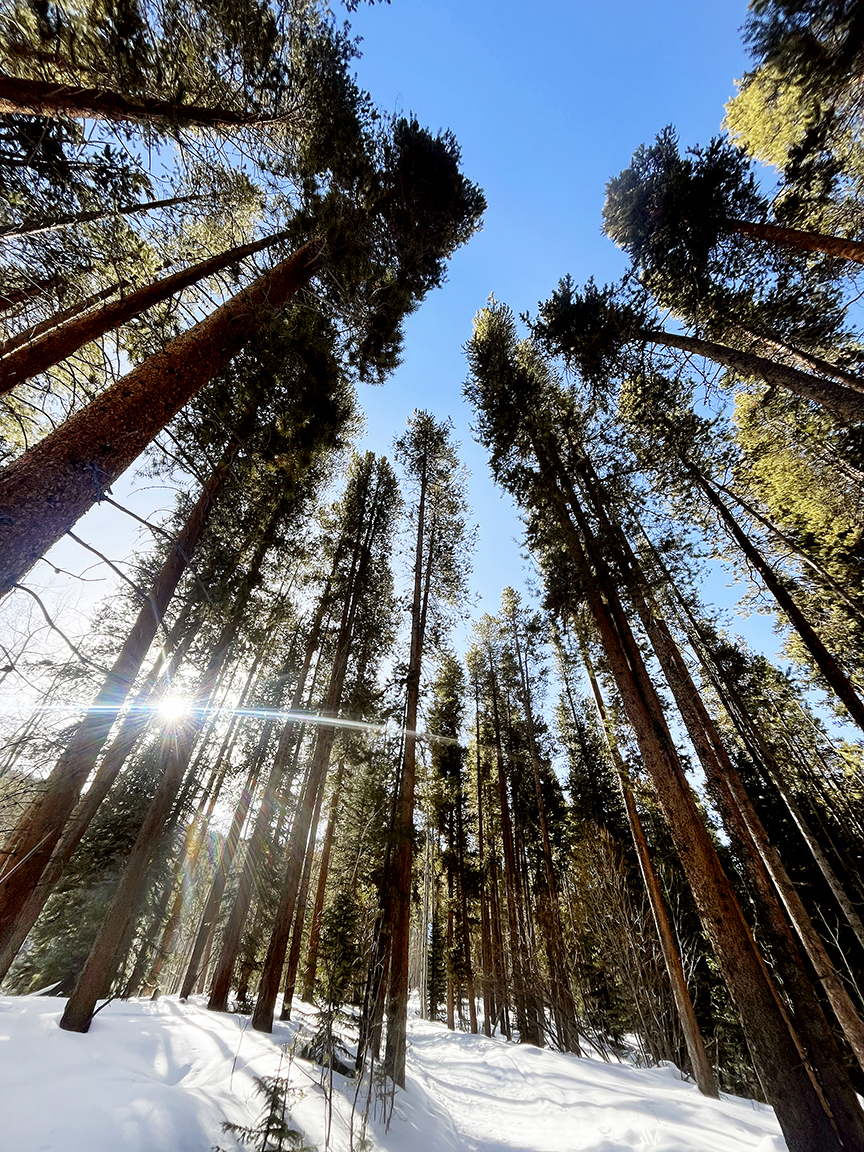Next time you’re on Smuggler, look up!

Towering lodgepole pines on Smuggler Mountain Open Space.
The views of Aspen from Smuggler Mountain Open Space are no doubt a highlight of the hike up Smuggler Mountain Road, but if you venture into the interior of the 232-acre open space, you’ll be treated to a different sort of spectacular sight. All you need to do is look up.
Aspens are the dominant tree species in many forested areas of the open space and rightfully own the spotlight each autumn, but the next time you’re making a loop across the open space on, say, the 10th Mountain Trail, crane your neck for a better look at the lodgepole pine trees. They are magnificent.
Mature lodgepole pines (Pinus contorta) dominate the eastern side of Smuggler Mountain Open Space. These trees are roughly 90 to 120 years old and reach heights of 80 feet or more. The towering specimens are unmistakable – straight, gradually tapering trunks shoot skyward toward a crown of branches and needles high overhead. Native Americans used the trees to build their lodges – hence the name, purportedly. When white settlers came west, the trees provided much of the lumber for railroad ties and, in early Aspen, the timber was used to shore up the area’s extensive mines. Lodgepoles remain an important source of lumber for structural timber and other wood products.
Smuggler is the only Pitkin County open space with a significant stand of lodgepoles, but across Colorado, these trees cover slightly more than 1.5 million acres, or 7 percent of the state’s forested lands, according to the Colorado State Forest Service. Colorado is close to the southern end of this species’ range. It is a familiar sight in the montane and subalpine forests of the Colorado Rockies, growing at between 8,000 and 10,000 feet in elevation.
It is no coincidence that Smuggler’s lodgepole pines are similar in their age and size. Left to natural forces, lodgepoles grow and die uniformly, often following wildfire. Some of the cones produced by lodgepoles are serotinous, meaning they are tightly fused and only open in extreme heat, releasing seeds for regeneration after a fire. Lodgepoles are often the first trees to occupy an open, sunny area after a disturbance such as fire.
On Smuggler, however, the disturbance was logging. The forest was clear-cut in the late 1800s, when the demand for timber for the mines and other construction left the mountainsides surrounding town denuded. The Smuggler Mine alone used 100,000 board feet a month in its underground operations, leaving the surrounding hillsides “as bare as a stretch of arctic tundra,” according to Malcomb J. Rohrbough in his chronicle of early Aspen, “Aspen – The History of a Silver Mining Town 1879-1893.” (A board foot is a calculation of the volume of lumber. For perspective, about 12,000 planks that are 1.25 inches thick, 10 inches wide and 8 feet long would total 100,000 board feet.)
Photographs of Smuggler Mountain from that era show a mountainside devoid of trees – very different from the Smuggler of today. But, lodgepoles are well adapted to the harsh conditions of the Rocky Mountains, including cold temperatures, high altitudes and poor soils. Not all lodgepole cones are serotinous and wind-dispersed seeds can quickly colonize open areas.
On Smuggler, Pitkin County Open Space and Trails keeps an eye on the lodgepoles in conjunction with regular monitoring of vegetation and wildlife. The community and local government sprang to action in 2009-’10 when mountain pine beetles were decimating huge swaths of lodgepoles around Colorado. Hundreds of “brood” trees containing the beetles were removed from the open space and adjacent lands, some flown out by helicopter, and packets of a pheromone were affixed to many other lodgepoles to fool adult beetles into leaving healthy trees alone.
The pine beetle outbreak subsided, but other pests, disease, drought and even wind pose potential threats to Smuggler’s lodgepole forest, which is dominated by trees that are all the same age and may be nearing the end of their natural life. This old-age uniformity makes the forest more susceptible to a die-off.
Part of the response to the pine beetle epidemic was the clearing of three small areas on Smuggler Mountain Open Space to allow forest regeneration. The cuts were successful in improving conditions for lodgepole seedlings, according to a 2019 Vegetation and Wildlife Monitoring Report for the open space. The report recommended continuing to create small clearings in the lodgepole forest, in essence mimicking the effect of fire.
Forest health on Smuggler Mountain Open Space is currently being evaluated within the context of a much broader assessment of forest health on about 5,500 acres spread across various county open spaces. The goal is to identify opportunities to improve forest health through a comprehensive plan for all properties rather than a piecemeal approach to projects on a per-property basis.
There will be much more to come about forest health on open spaces, and Smuggler Mountain Open Space will be the focus of a management plan update starting this year.
In the meantime, look up!
– By Pitkin County Open Space and Trails
